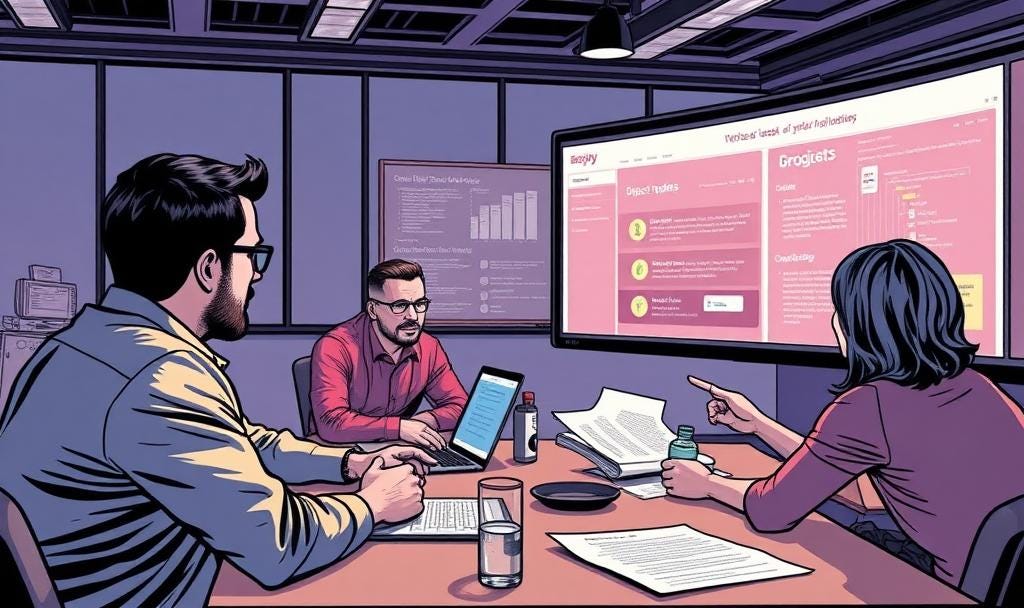Chapter 8: The Communication Strategy
JJ introduces a comprehensive communication plan to ensure long-term success and buy-in across FinTechNova stakeholders and customers.
JJ stood before the executive board, his heart racing but his voice steady. It was day 60 of their 90-day AI transformation challenge, and he was about to present their progress and future plans.
"Ladies and gentlemen," JJ began, "over the past two months, we've not just implemented AI—we've begun to fundamentally transform how FinTechNova operates."
He clicked to the first slide, showcasing their key metrics:
- Customer satisfaction up by 15%
- Average handling time (AHT) reduced by 30%
- First contact resolution improved by 25%
Richard Nomura, the board chairman, leaned forward, his interest piqued. "Impressive numbers, JJ. But how sustainable is this? And what's next?"
JJ nodded, appreciating the direct question. "Excellent point, Richard. That's exactly why I'm here today. We're not just implementing AI; we're creating a new communication strategy to ensure long-term success and buy-in across the organization."
He moved to the next slide, outlining their communication plan:
- Weekly Town Halls
- Daily Standups for the AI team
- Monthly All-Hands meetings
- Quarterly Board Updates
- AI Performance Dashboard (accessible to all employees)
"Transparency is key," JJ emphasized. "We want everyone, from our customer service reps to our C-suite executives, to understand and be part of this transformation."
Maya, who had joined JJ for the presentation, chimed in. "We've also implemented a feedback loop system. Our employees can directly contribute to improving the AI, which has significantly boosted engagement and adoption."
One of the board members, a woman in her 50s, spoke up. "This all sounds good, but what about our customers? How are we communicating these changes to them?"
JJ smiled, glad the question had been asked. "Great question. We've developed a multi-pronged approach for customer communication." He clicked to the next slide:
Customer Communication Strategy:
- Gradual roll-out with opt-in option
- Clear labeling of AI-assisted interactions
- Feedback mechanism after each interaction
- Monthly customer surveys on AI experience
- Dedicated AI FAQ section on our website and internal comms
"We're being fully transparent with our customers," JJ explained. "We want them to be part of this journey, to provide feedback and help us improve."
Richard nodded approvingly. "And our employees? How are they responding to these changes?"
Maya took this question. "Initially, there was some apprehension, as expected. But our focus on upskilling rather than replacement has been well-received. We've seen a 40% increase in employee satisfaction scores since implementing our AI training programs."
As the presentation continued, JJ could see the board members becoming more engaged, asking detailed questions about the technology, the process, and the future plans.
At the end of the hour-long session, Richard stood up. "JJ, Maya, this is impressive work. You've not only shown tangible results but also a clear strategy for sustainable growth and communication. I look forward to seeing how this develops in the final month of your challenge."
As they left the boardroom, JJ felt a weight lift off his shoulders. They had the board's support, and more importantly, they had a clear communication strategy to drive the AI transformation forward.
He turned to Maya. "Great job in there. Now, let's make sure we action this communication plan. I want our first town hall scheduled for next week."
Maya nodded, already pulling out her tablet to make notes. "On it, JJ. And I'll work with the marketing team on the customer communication rollout."
As they walked back to their offices, JJ couldn't help but feel a sense of pride. They were not just implementing AI; they were changing the very culture of FinTechNova. And with clear, consistent communication, they were bringing everyone along on this transformative journey.
He made a mental note: "Day 60 of 90: Communication strategy approved. Next step: First AI Town Hall in 7 days."
The final stretch of their 90-day challenge was approaching, and JJ was determined to finish strong, with every employee and customer fully informed and engaged in their AI-driven future.
TLDR: Chapter 8 Summary
Chapter 8 - The Communication Strategy. Manage up, down and all over.
JJ presents the team's 90-day AI transformation progress to the executive board, showcasing impressive metrics in customer satisfaction and efficiency. He introduces a comprehensive communication plan to ensure long-term success and buy-in across FinTechNova. The strategy includes regular town halls, standups, and an AI performance dashboard for employees, as well as a transparent approach for customers with opt-in options and feedback mechanisms. Despite initial employee apprehension, the focus on upskilling has led to increased job satisfaction. The board approves the communication strategy, setting the stage for the final push in the AI transformation journey. JJ and his team prepare to bring every employee and customer on board with their AI-driven future.
Glossary for Chapter 8: The Communication Strategy
All-Hands Meeting
A gathering of an entire organization or department to discuss important matters. Did you know? Companies that hold regular all-hands meetings report 23% higher employee engagement scores.
AI Performance Dashboard
A visual display of key AI metrics and performance indicators, accessible to employees. Why important? Organizations using data dashboards are 5x more likely to make faster decisions.
Feedback Loop
A system where output or results are used as input for future improvements. This is very important because companies with robust feedback loops in AI development report 40% faster improvement in AI model performance.
AI-Assisted Interactions
Customer interactions that involve both AI systems and human agents.
Opt-In Option
A choice given to customers to participate in or use a new service or feature.
AI FAQ
A dedicated section on a website that answers common questions about AI implementation and its impact on services. Organizations with comprehensive AI FAQs report 30% fewer customer inquiries about AI-related changes.





